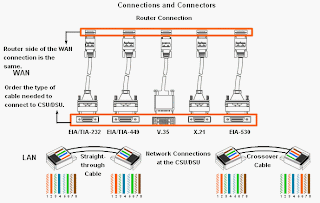
The WAN Physical layer describes the interface between the data terminal equipment (DTE) and the data circuit-terminating equipment (DCE). Generally, the DCE is the service provider and the DTE is the attached device. In this model, the services offered to the DTE are made available either through a modem or a CSU/DSU.
Typically, the router is the DTE device and is connected to a CSU/DSU, which is the DCE device. The CSU/DSU (DCE device) is used to convert the data from the router (DTE device) into a form acceptable to the WAN service provider. The CSU/DSU (DCE device) is also responsible for converting the data from the WAN service provider into a form acceptable by the router (DTE device). The router is usually connected to the CSU/DSU using a serial DTE cable, as shown.
Serial interfaces require a clock signal to control the timing of the communications. In most environments, the service provider (a DCE device such as a CSU/DSU) will provide the clock. By default, Cisco routers are DTE devices. However, in a lab environment, we are not using any CSU/DSUs and, of course, we do not have a WAN service provider.(more information)
src="http://pagead2.googlesyndication.com/pagead/show_ads.js">

